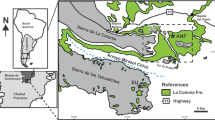Abstract
Two genera and three species of adapid primates are known from the middle and late Miocene of India and Pakistan. Most fossil specimens are fragmentary, but the best-known species, Sivaladapis nagrii,is now represented by enough specimens to permit composite reconstruction of much of the dentition. The incisors of Sivaladapishave spatulate crowns, and the canines are large, projecting teeth. Premolars and molars exhibit complex occlusion involving simultaneous approximation of pointed leading cusps on upper and lower molars, with linear trailing lophs. The premolar eruption sequence in Sivaladapisappears to be P2-P4-P3, as in most extant prosimians. Symphyseal fusion of the mandibular rami occurred early in ontogeny, before the eruption of any of the anterior permanent teeth. We interpret Sivaladapisto have been a specialized arboreal folivore that became extinct near the end of the Miocene, when the distribution of forests was increasingly restricted and colobine monkeys first invaded South Asia.
Similar content being viewed by others
References
Barry, J. C. (1980). Occurrence of a hyaenodontine creodont (Mammalia) in the late Miocene of Pakistan.J. Paleontol. 54: 1128–1131.
Barry, J. C., Lindsay, E. H., and Jacobs, L. L. (1982). A biostratigraphic zonation of the middle and upper Siwaliks of the Potwar Plateau of northern Pakistan.Palaeogeogr. Palaeoclimatol. Palaeoecol. 37: 95–130.
Beecher, R. M. (1983). Evolution of the mandibular symphysis in Notharctinae (Adapidae, Primates).Int. J. Primatol. 4: 99–112.
Chopra, S. R. K., and Kaul, S. (1979). A new species ofPliopithecus from the Indian Siwaliks.J. hum. Evol. 8: 475–477.
Chopra, S. R. K., and Vasishat, R. N. (1979). Some observations on the dentition of newIndraloris (Primates) fossil material from the Nagri deposits of Haritalyangar (H.P.), India, with remarks on the taxonomic status ofSivanasua (Carnivora) from the Siwaliks of the Indian subcontinent.VII Congr. Int. Primatol. Soc. Abstr. Papers, Macmillan India Press, Madras, p. 144.
Chopra, S. R. K., and Vasishat, R. N. (1980a). A new Mio-PlioceneIndraloris (Primates) material with comments on the taxonomic status ofSivanasua (Carnivora) from the Sivaliks of the Indian subcontinent.J. hum. Evol. 9: 129–132.
Chopra, S. R. K., and Vasishat, R. N. (1980b). Première indication de la présence dans le Mio-Pliocene des Siwaliks de l’Inde d’un Primate adapidé,Indoadapis shivaii, nov. gen., nov. sp.C.R. Acad. Sei. Paris 290: 511–513.
Fleagle, J. G., Kay, R. F., and Simons, E. L. (1980). Sexual dimorphism in early anthropoids.Nature 287: 328–330.
Flynn, L. J., and Jacobs, L. L. (1982). Effects of changing environments on Siwalik rodent faunas of northern Pakistan.Palaeogeogr. Palaeoclimatol. Palaeoecol. 38: 129–138.
Gingerich, P. D., and Sahni, A. (1979).Indraloris andSivaladapis: Miocene adapid primates from the Siwaiiks of India and Pakistan.Nature 279: 415–416.
Gingerich, P. D., Smith, B. H., and Rosenberg, K. (1982). Allometric scaling in the dentition of primates and prediction of body weight from tooth size in fossils.Am. J. phys. Anthropol. 58: 81–100.
Hartenberger, J.-L. (1982). A review of the Eocene rodents of Pakistan.Contrib. Mus. Paleontol. Univ. Mich. 26: 19–35.
Jacobs, L. L. (1981). Miocene lorisid primates from the Pakistan Siwaliks.Nature 289: 585–587.
Johnson, G. D., and Vondra, C. F. (1972). Siwalik sediments in a portion of the Punjab reentrant: The sequence at Haritalyangar, District Bilaspur, H. P.Himalayan Geol. (Wadia Inst. Delhi) 2: 118–144.
Kay, R. F. (1975). The functional adaptations of primate molar teeth.Am. J. phys. Anthropol. 43: 196–216.
Kay, R. F., and Hiiemae, K. M. (1974). Jaw movement and tooth use in recent and fossil primates.Am. J. phys. Anthropol. 40: 227–256.
Kay, R. F., and Hylander, W. L. (1978). The dental structure of mammalian fplivores with special reference to Primates and Phalangeroidea (Marsupialia). In Montgomery, G. G. (eds.),The Biology of Arboreal Folivores, Smithsonian Institution Press, Washington, D.C., pp. 173–191.
Lewis, G. E. (1933). Preliminary notice of a new genus of lemuroid from the Siwaliks.Am. J. Sci. 26: 134–138.
Pilgrim, G. E. (1932). The fossil Carnivora of India.Mem. Geol. Surv. India 18: 1–232.
Prasad, K. N. (1963). Fossil Carnivora from the Siwalik beds of Haritalyangar, Himachal Pradesh.Indian Minerals 17: 95.
Prasad, K. N. (1970). The vertebrate fauna from the Siwalik beds of Haritalyangar, Himachal Pradesh, India.Mem. Geol. Surv. India 39: 1–55.
Rose, K. D., and Simons, E. L. (1977). Dental function in the Plagiomenidae: Origin and relationships of the mammalian order Dermoptera.Contrib. Mus. Paleontol. Univ. Mich. 24: 221–236.
Schwartz, J. H. (1975). Development and eruption of the premolar region of prosimians and its bearing on their evolution. In Tattersall, I., and Sussman, R. W. (eds.),Lemur Biology, Plenum, New York, pp. 41–63.
Shigehara, N. (1980). Epiphyseal union, tooth eruption, and sexual maturation in the common tree shrew, with reference to its systematic problem.Primates 21: 1–19.
Simons, E. L. (1972).Primate Evolution, an Introduction to Man’s Place in Nature, Macmillan, New York, pp. 1–322.
Stehlin, H. G. (1912). Die SÄugetiere des schweizerischen Eocaens—Adapis.Abh. Schweiz. PalÄont. Ges. 38: 1165–1298.
Szalay, F. S., and Delson, E. (1979).Evolutionary History of the Primates, Academic Press, New York, pp. 1–580.
Tattersall, I. (1968). A mandible ofIndraloris (Primates, Lorisidae) from the Miocene of India.Postilla Yale Peabody Mus. 123: 1–10.
Thomas, H., and Verma, S. N. (1979). Découverte d’un Primate adapiforme (Sivaladapinae subfam. nov.) dans le Miocène moyen des Siwaliks de la région de Ramnager (Jammu et Cachemire, Inde).C.R. Acad. Sci. Paris 289: 833–836.
Author information
Authors and Affiliations
Rights and permissions
About this article
Cite this article
Gingerich, P.D., Sahni, A. Dentition ofSivaladapis nagrii (Adapidae) from the late Miocene of India. Int J Primatol 5, 63–79 (1984). https://doi.org/10.1007/BF02735148
Received:
Revised:
Issue Date:
DOI: https://doi.org/10.1007/BF02735148




